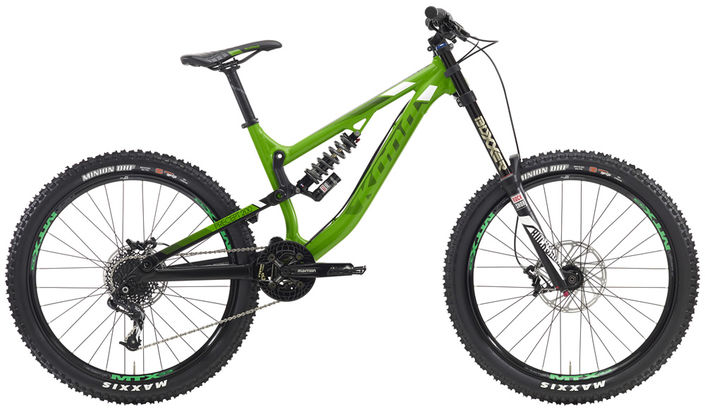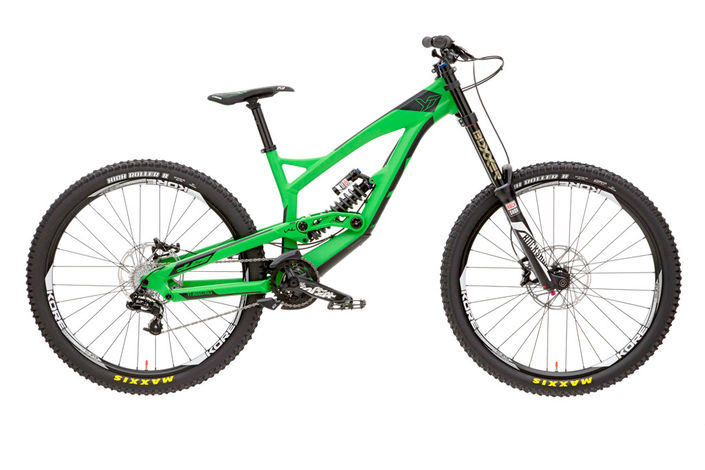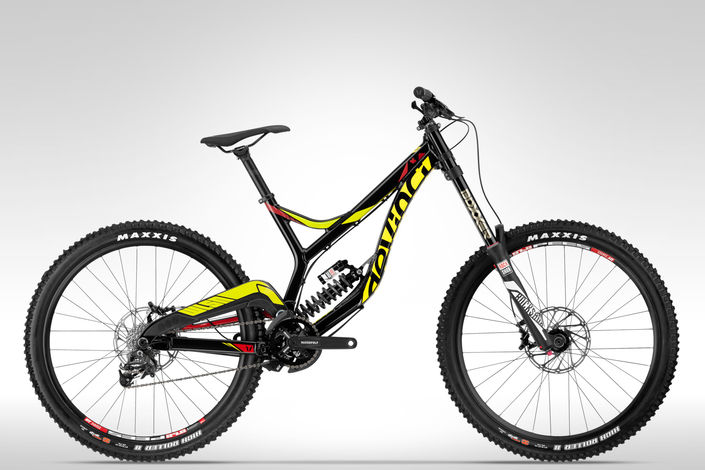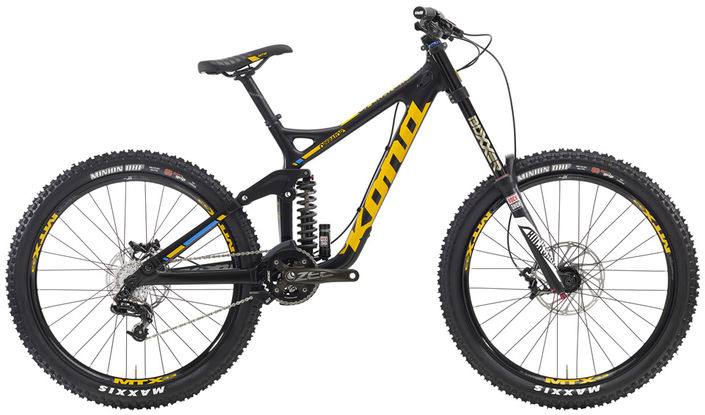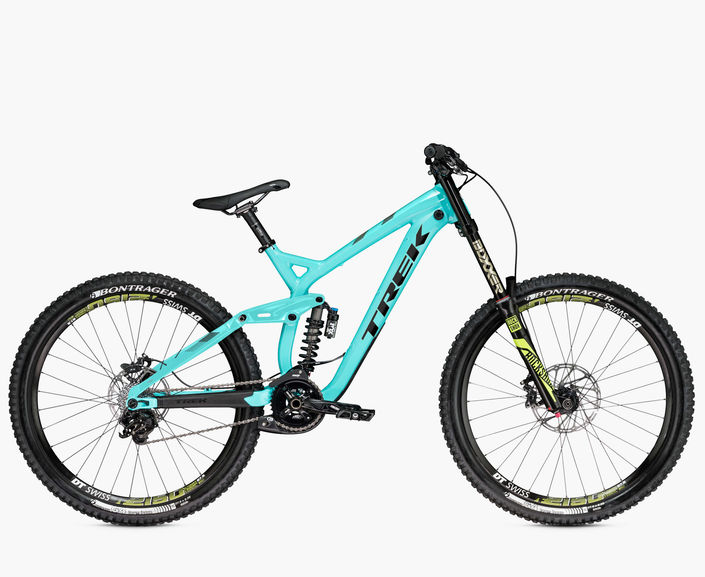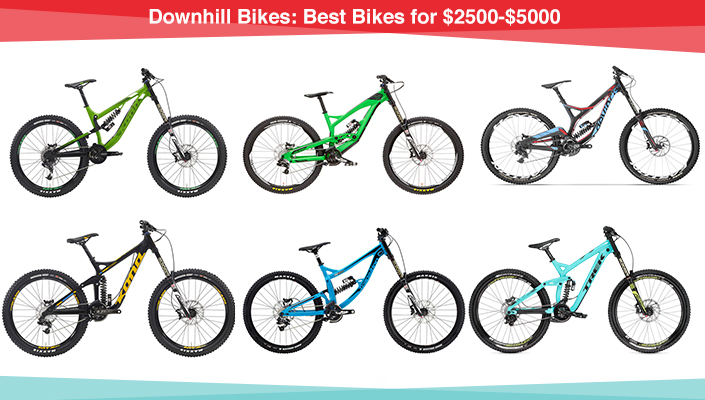
Downhill bikes are quite often the culmination of both the ultimate technology and intense passion for most bike manufacturers. The challenges faced by downhill bikes are immense: impact, repetition, and unforeseen circumstance all take their toll on the bikes. With the ability to ride 4900 vertical feet in ONE RUN alone in a place like Whistler Bike Park, the amount of descending downhill bikes do is jaw dropping, not to mention DH trails are the most abusive bike destroying trails one can find.
Because of the intensity of the riding, any weakness in a DH bike is quickly exposed. This creates a situation for bike companies where the bike will be purposefully abused its whole life, but it also needs to be kept affordable in price. After selling DH bikes for over a decade, I quickly learned that any company can produce the best performing, all carbon, DH monster that can be piloted to a World Cup win. But if the bike isn't reliable or affordable, despite everyone wanting it, no one will actually buy it.
With modern top tier DH bikes coming in at $13k and up, it can be a hard to understand what level of bike is best for the average consumer. So, when picking a best of list, durability, affordability, and value play the biggest roles in deciding which ones make the cut. Here are our choices for the best DH bikes of 2016:
Kona Precept 200 - $2849 USD
Never afraid to do things differently, Kona really went after the entry-level DH bike market hard with the well-rounded Precept 200. Most companies place their pride in having a crown jewel DH bike that costs, well, as much as crown jewels. Kona, on the other hand, have been extremely proud of their entry level DH offering. Citing "performance-loaded, value-stacked downhill bike," Kona took design cues from its Operator to make the Precept ride as well as possible for the price.
The Precept 200 features RockShox Kage R shock and a Boxxer RC fork, and yes, this is the same fork that is found on both the Carbon Kona Operator and the Trek Session 88 also appearing in this article. The Precept's 26" wheels are wrapped in Maxxis Minion DHF tires and easily stopped by SRAM Guide R brakes. The leverage rate of the rear suspension feels pretty stock, but will get the job done for smashing DH laps.
The frame is fairly decent looking despite it lacking the same refinements of the other bikes on this list. The 7000 series aluminum carries straight lines with no internal cable routing and gusseting on all major junctions. The pivots are large and exposed making them relatively durable, yet easy to work on. The story here is the fact that you get a lifetime warranty on this entry level DH bike, which could put a lot of customers at ease.
Pros:
- Value
- Reliability
Cons:
- Weight
- Un-refined look
YT Tues AL/CF - $2899/$4499 USD
As a newcomer, YT have managed to do what most older companies have failed in trying: bring value to the DH market. When images of the 27.5 YT Tues first emerged, other companies in the industry didn't pay much notice - that was until YT released the price. Two build levels of the Tues fit into our $3000-$5000 range giving you, the rider, the option of carbon or aluminum framesets and subsequent levels in build kit quality.
Both trim levels of the Tues feature mainly SRAM build kits, with the aluminum getting a RockShox Kage RC shock and a Boxxer RC for a fork. The carbon Tues uses a RockShox Vivid R2C shock and a Boxxer Team fork. The derailleurs on both are SRAM X9 and the cockpits are spec'd by Race Face. Stopping happens thanks to SRAM Guide R and Guide RS brakes on 200mm rotors.
The Tues is the definition of long and low with a TT length of 624mm for the large - it is over 12mm longer then the Kona Operator. This length and the 27.5" wheels means the Tues may struggle at lower speeds and on tight tracks, so ride it fast. The jury is still out on the durability of the Tues, but considering it has already won a World Cup under Aaron Gwin and has also won RedBull Rampage under Andreu Lacondeguy, let's go ahead and say it's built pretty darn well.
Pros:
- Value
- Ride Quality
Cons:
- Might be too long for short riders
Devinci Wilson - $3299 USD
The performance from the pride of Quebec, Devinci Wilson cannot be argued with. Steve Smith piloted the Wilson to a World Cup overall title in 2013 which solidified it as one of the industry's fastest bikes. The Wilson comes in multiple trim levels and both a carbon and aluminum version fit in our price window. The Wilson has a distinct low, squatted look that has really appealed to people. The carbon frame lends a little nicer to the eye as the carbon construction allows for more fluid lines. With that being said, there is little to no difference between the carbon and alloy Wilson, save for a pound loss and a $1000 increase in price.
The Wilson is a wheels-to-the-ground blistering race bike and being able to get one for $3299 means any average weekend warrior racer can get one. The Wilson uses Devinci's 'Split Pivot' system for the rear end, essentially making it a single pivot - linkage hybrid. There is a single main pivot on the frame just above the shock mount and the BB, but the shock itself is linkage driven, thus giving the Wilson the best of both suspension systems. The shock is mounted to a 'Control Link" which floats concentrically around the BB and connects to the swing arm, increasing the stiffness and smooth suspension feel throughout its travel. There is also a concentric drop-out pivot allowing for controlled braking. All this equals smooth travel and braking through thunderous trails at any speed.
The alloy Wilson comes spec'd with the usual suspect Boxxer RC, but gets a decent upgrade in the RockShox Vivid R2C rear shock. The stoppers are SRAM Guide R's and the drivetrain is an interesting mix of SRAM X7 derailleur and Shimano 105 chain and cassette. The frame does fit quite short with a reach of 436mm, making the cockpit feel pretty tight. The Wilson, with all its engineering prowess, will require a considerable amount more maintenance then the other bikes on this list; as I always say - more moving parts, more maintenance. If you want an out of the box race bike for your weekend races, Devinci has you covered with their Wilson 27.5 XP alloy.
Pros:
- Value
- Performance
Cons:
- Cramped cockpit for tall riders
Kona Operator - $3799 USD
When Kona redesigned their Operator back in 2013 they had a very clear focus: to create a bike that was reliable, fun, stiff, and remained affordable. After many years in development Kona seemed to hit all the right notes with their redesigned carbon Operator. The walking beam 4-bar suspension design is not new to Kona, but after multiple different prototype designs Kona settled on tweaking their tried-and-tested design. This is a decision I can respect because it negates the extra costs of completely redesigning the bike, which then raises the final price for the consumer. If the gains of a newer design are negligible at best, then why make the consumer pay more for it? Many companies are guilty of doing this just to increase flat sales, Kona knows this and refused to do the same to its customers.
The carbon Operator comes with a respectable blend of SRAM and Kona parts, seeing the use of the fantastic RockShox Kage RC rear shock and Boxxer RC fork. With a quick RockShox Charger Damper upgrade the Boxxer RC will feel top shelf. The stoppers are SRAM Guide R and the drive train is a blend of Shimano ZEE and SRAM X9. 26" wheels still adorn the operator for strength and bike park reliability. The build kit is mid-grade at best, but it was carefully selected to meet the performance needs of a DH bike, with workhorse reliability.
The carbon front triangle and aluminum rear end are bridged by a carbon/aluminum rocker and oversized pivot bearings, making the carbon Operator one stiff rig. Other nice features include the built in fork bumpers/internal cable routing plugs, replaceable downtube protector, and chain stay protector. The Operator is a lively ride that can jump, silently smash through chunder, and confidently be raced on the World Cup circuit, all with retaining its affordability.
Pros:
- Fun, lively ride
- Carbon front triangle
Cons:
- Suspension could be upgraded
![]() Check out the Comparison
Check out the Comparison
4 of the best DH bikes from Kona, YT, and Devinci
Transition TR500 3 - $3899 USD
The champion of the everyman, Transition has built a cult-like following of their blue-collar line of bikes. The TR500 is no exception. The TR500 blends two previous Transition gravity rigs, the TR250 and the TR450, into one concise DH slayer.
Although Transition found success with both the TR250 and the TR450, they eventually found there was no need for both and that they could build one bike to do both jobs. The TR500 has a flip-able link that allows the rider to change the head tube angle from 63-63.5 degrees and has multiple shock mounting positions allowing the suspension to be run in either 180mm or 203mm positions. The rear end also sees dropouts that can be changed from 434mm chain stay lengths to 442mm. All this means that you can tune the bike to ride like either a shorter travel, more playful park bike, or as a long and low World Cup racer. The bike can handle 26" or 27.5" wheels as well as a single or dual crown fork, making the TR500 appealing to all types of riders.
The bike comes spec'd with a RockShox Kage RC shock and a Boxxer RC fork, Race Face Chester cockpit, Shimano Deore brakes, and SRAM's new GX derailleur. The TR500 has a nice, low-slung look, internal cable routing, and a smart frame design that allows the rear shock to be mounted in the split seat tube.
Pros:
- Durability
- Versatility
- All-around performance
Cons:
- Deore brakes may wear out quickly
Trek Session 88 - $4999 USD
The Trek Session is a proven winner once piloted to 9 World Cup wins in 14 races under Aaron Gwin. Yes, the Trek Session 88 sits atop our price range at $4999 USD, features a build kit near that of the Kona Operator, and is full aluminum, but hear me out. The ride quality Trek painstakingly designed out of the Session is simply sublime.
Trek's ABP, or Active Braking Pivot, combine with their Full Floater suspension design help make sure the Session is blistering fast, smooth, stable, and confidence inspiring. The ride feel is sophisticated and refined; you know when you are on a Session. Trek has custom tuned the Fox supplied VAN RC rear shock so it works seamlessly with Trek's suspension design. The Boxxer RC fork can be easily upgraded with a RockShox Charger Damper to give you some extra umph support up front. The frame and suspension may make the most out of the 27.5" wheels now on most DH rigs, allowing the rider to feel grounded and in control of the larger wheels.
The Trek Session frame may be visually the most recognized silhouette in the DH world. The perfect blend of slope and straight lines make the Session stand out as an icon in design. The sleek internal cable routing and replaceable downtube protector keep the lines looking clean while the bright, glossy paint draws a lot of attention. The MINO Link allows you to quickly change the geometry by ½ degree without affecting the suspension feel, allowing you to make the Session feel even more incredible as per needed.
Pros:
- Adjustability
- Performance
Cons:
- Price
![]() Check out the Comparison
Check out the Comparison
4 of the best DH bikes from Kona, Trek, Transition, and Devinci

RELATED ARTICLE:
Best XC Full Suspension Bikes for $1500-$3000
Looking for a new entry to mid level full suspension bike?BikeRoar has you covered with 6 of the best bikes for... READ MORE

RELATED ARTICLE:
6 Best Mountain Bike Tires for 2016
losing your grip? or maybe you're just in the market for some new tires?BikeRoar gives you their definitive list of the best tires...READ MORE
